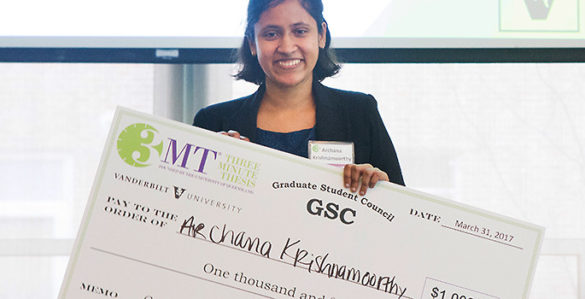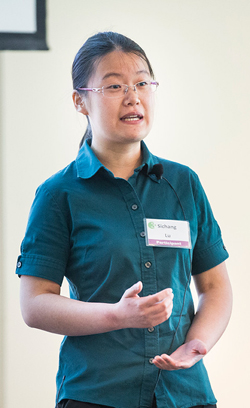
Biological clocks and insulin production. Mental illness and malfunctioning vacuum cleaners. The secret ingredients for making lobster spaghetti and better bone grafts.
These were the subjects of the winning presentations in Vanderbilt University’s fifth annual Three Minute Thesis (3MT) Competition held March 31.
The competition, put on by the Graduate Student Council, challenges graduate students to explain their research to a lay audience in just three minutes with only one PowerPoint slide. That is a dramatic contrast to their Ph.D. theses, which are typically 80,000 words long and can take more than eight hours to present.

This year, nearly 50 graduate students took the challenge and entered the competition. Ten finalists were selected to give their presentations to a distinguished panel of judges that consisted of Associate University Librarian for Research and Learning Cliff Anderson; Executive Director of Global Learning and Education Susan Barone; Michael Cass, speechwriter and communications adviser in the Nashville mayor’s office; Claudia Deane, vice president for research at the Pew Research Center; Morgan Massengill, producer of The Bobby Bones Show at iHeartMedia; professional storyteller and visual artist Tricia Rose Burt; and Dean of the Graduate School Mark Wallace.
The panel’s votes were tabulated to determine the top two presentations, and a third “people’s choice” award was given based on an audience vote. The first place prize was $1,000. Second place was $500. And the people’s choice award received $350.
Biochemistry graduate student Archana Krishnamoorthy took first place with her presentation titled “Carpe Tempum: Seize the Time.” She described her research, which involved making yeast glow in the dark in order to discover that yeast has daily biorhythms similar to those in humans. This new knowledge is important because it can be used to increase the efficiency of yeast-based production of drugs like insulin and antibiotics.

The runner-up was neuroscience graduate student Raajaram Gowrishankar with his presentation “Emerging Insights Into Mental illness: What’s Wrong with my Vacuum Cleaner?” The worldwide cost of treating mental illness tops $2.5 trillion, and we don’t have an effective treatment, he explained. However, it has been established that many mental illnesses are associated with variations in the levels of the neurotransmitter dopamine. He is studying the genes that make the molecular “vacuum cleaners” in the brain that suck up the excess dopamine that is released when nerves fire. He has found a mutation that makes these tiny vacuums run in reverse, causing elevated levels of dopamine. His goal is to find a way to “reverse this reversal,” which could provide the basis for an effective treatment for mental illness.
Winner of the people’s choice award was chemical and biomolecular engineering graduate student Sichang Lu for her presentation titled “Resorbable Nanocomposites with Bone-like Strength and Enhanced Cellular Activity.” In her talk she compared her research on a formula for a better bone graft material with attempting to figure out the best ingredients for making lobster spaghetti. Both required identifying a secret ingredient, she explained. Currently, there are two basic materials that are used for bone grafts: polymer, which is very strong but is biologically inert; and ceramic, which is biologically active but is too weak to bear much weight. She explained that she has discovered a way to combine the two to create a composite material that is both strong and biologically active. (The secret to making great lobster spaghetti, she revealed, is adding cheese.)

The other finalists were: Elizabeth Lanphier in philosophy (“A House is not a Home: But Why You Ought to Offer Hospitality in Each”); Allison Gilmour in special education (“Teaching Students with Disabilities is Associated with Teacher Turnover”); Edward van Opstal in biological sciences (“Making a Microbiome: Nature vs. Nurture”); Daniel Kashima in neuroscience (“Drugs are Sick: TLR4 and Reward Learning”); May Shen in psychology (“The Quest for Visual Expertise”); Ilisa Butera in neuroscience (“Listening Through Your Eyes”); and Samantha Sarett in biomedical engineering (“Leveling Albumin as a Natural Carrier for siRNA”).
“Thank you for making me part of this extraordinary gathering of talent and hope,” Chancellor Nicholas S. Zeppos said at the conclusion. “How proud I am that you, our graduate students, are doing such extraordinary work. You are brilliant—entertaining and brilliant. I could listen to you all day!”
The event was co-sponsored by the Graduate School, College of Arts and Science, School of Engineering, BRET Office of Career Development, Peabody College of education and human development, Robert Penn Warren Center, English Language Center and the Writing Studio.
The 3MT competiton was invented at the University of Queensland in Australia in 2008 and has proven so popular that it has now spread to more than 480 universities and research institutions in 58 countries. Vanderbilt was one of the first universities in the United States to adopt it.